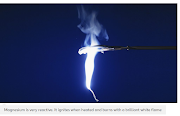The reactivity series
Some metals are very unreactive. This means they do not easily take part in chemical reactions. For example, platinum does not react with oxygen in the air, even if it is heated in a Bunsen burner flame.
Some metals are very reactive. They easily take part in chemical reactions to make new substances.
Other metals may be more reactive than magnesium, or in between magnesium and platinum. If we put the metals in order of their reactivity, from the most reactive down to the least reactive, we get a list called the reactivity series.
If you want to learn the reactivity series, you could try making up a mnemonic or silly sentence to help. Here's one:
"Pond slime can make a zoo interesting - the long crinkly sort goes purple."
This is the general word equation for the reaction:
metal + acid → salt + hydrogen
For example, magnesium reacts with hydrochloric acid to produce magnesium chloride:
magnesium + hydrochloric acid → magnesium chloride + hydrogen
Mg + 2HCl → MgCl2 + H2
It doesn't matter which metal or which acid is used if there is a reaction we always get hydrogen gas as well as the salt.
Displacement reactions are easily seen when a salt of the less reactive metal is in the solution. During the reaction:
For example, magnesium is more reactive than copper. When a piece of magnesium is dipped into blue copper sulfate solution:
Here are the equations for the reaction:
magnesium + copper sulfate → magnesium sulfate + copper
Mg + CuSO4 → MgSO4 + Cu
No reaction is seen if you do things the other way round – in other words, if you put the copper powder into magnesium sulfate solution. This is because copper is not reactive enough to displace magnesium from magnesium sulfate.
Magnesium displaces three metals, zinc displaces two metals, iron displaces one metal and copper does not displace any of the other three metals. So, the order of reactivity, starting with the most reactive first, is:
Displacement reactions can also involve metal oxides.
Less reactive metals than carbon can be extracted from their oxides by heating with carbon. In general:
metal oxide + carbon → metal + carbon dioxide
This works for zinc, iron, tin, lead, and copper. Copper is the least reactive of these five metals.
Extracting copper from copper oxide
To extract copper, you mix copper oxide powder with carbon powder. You then heat the mixture strongly for a few minutes in a crucible. It is important to keep a lid on the crucible, otherwise, the carbon will react with oxygen in the air, rather than with the copper oxide. The carbon dioxide formed in the reaction escapes into the air.
After letting the crucible cool down, you tip the mixture into cold water. Pieces of brown copper sink to the bottom, leaving unreacted powder suspended in the water.
These equations represent the reaction:
copper oxide + carbon → copper + carbon dioxide
2CuO + C → 2Cu + CO2
Iron is less reactive than carbon, so it can be extracted from iron oxide using carbon. This is done on an industrial scale in a huge container called a blast furnace.
Lumps of iron oxide are mixed with carbon and dropped into the top of the blast furnace. Hot air is blasted in at the bottom. The oxygen in the air reacts with the carbon, forming carbon monoxide:
carbon + oxygen → carbon monoxide
2C +O2 → 2CO
It is hot enough in the blast furnace for the carbon monoxide to react with the iron oxide:
iron oxide + carbon monoxide → iron + carbon dioxide
Fe2O3 + 3CO → 2Fe + 3CO2
Some metals are very reactive. They easily take part in chemical reactions to make new substances.
Other metals may be more reactive than magnesium, or in between magnesium and platinum. If we put the metals in order of their reactivity, from the most reactive down to the least reactive, we get a list called the reactivity series.
If you want to learn the reactivity series, you could try making up a mnemonic or silly sentence to help. Here's one:
"Pond slime can make a zoo interesting - the long crinkly sort goes purple."
Reactions of acids with metals
Acids react with most metals and, when they do, salt is produced. But unlike the reaction between acids and bases, we do not get water. Instead, we get hydrogen gas.This is the general word equation for the reaction:
metal + acid → salt + hydrogen
For example, magnesium reacts with hydrochloric acid to produce magnesium chloride:
magnesium + hydrochloric acid → magnesium chloride + hydrogen
Mg + 2HCl → MgCl2 + H2
It doesn't matter which metal or which acid is used if there is a reaction we always get hydrogen gas as well as the salt.
Displacement reactions
Displacement reactions involve metal and a compound of a different metal. In a displacement reaction:- a more reactive metal will displace a less reactive metal from its compounds
Displacement reactions are easily seen when a salt of the less reactive metal is in the solution. During the reaction:
- the more reactive metal gradually disappears as it forms a solution
- the less reactive metal coats the surface of the more reactive metal
For example, magnesium is more reactive than copper. When a piece of magnesium is dipped into blue copper sulfate solution:
- the blue color fades as colorless magnesium sulfate solution forms
- brown copper coats the surface of the magnesiumHowever, how quickly the reaction goes depends on the metal used and how high up in the reactivity series it is.
Here are the equations for the reaction:
magnesium + copper sulfate → magnesium sulfate + copper
Mg + CuSO4 → MgSO4 + Cu
No reaction is seen if you do things the other way round – in other words, if you put the copper powder into magnesium sulfate solution. This is because copper is not reactive enough to displace magnesium from magnesium sulfate.
Investigating displacement
You can investigate the reactivity of metals using displacement reactions. The table shows the results from a series of experiments involving four metals and solutions of their salts. A tick shows where there is a visible reaction and across shows where there is no visible reaction.Magnesium displaces three metals, zinc displaces two metals, iron displaces one metal and copper does not displace any of the other three metals. So, the order of reactivity, starting with the most reactive first, is:
- magnesium
- zinc
- iron
- copper
Displacement reactions can also involve metal oxides.
Obtaining metals from metal oxides
Carbon is a non-metal but it is more reactive than some metals. This means that some metals can be extracted from their metal oxides using carbon.Less reactive metals than carbon can be extracted from their oxides by heating with carbon. In general:
metal oxide + carbon → metal + carbon dioxide
This works for zinc, iron, tin, lead, and copper. Copper is the least reactive of these five metals.
Extracting copper from copper oxide
To extract copper, you mix copper oxide powder with carbon powder. You then heat the mixture strongly for a few minutes in a crucible. It is important to keep a lid on the crucible, otherwise, the carbon will react with oxygen in the air, rather than with the copper oxide. The carbon dioxide formed in the reaction escapes into the air.
After letting the crucible cool down, you tip the mixture into cold water. Pieces of brown copper sink to the bottom, leaving unreacted powder suspended in the water.
These equations represent the reaction:
copper oxide + carbon → copper + carbon dioxide
2CuO + C → 2Cu + CO2
Extracting iron from iron oxide
Iron is less reactive than carbon, so it can be extracted from iron oxide using carbon. This is done on an industrial scale in a huge container called a blast furnace.Lumps of iron oxide are mixed with carbon and dropped into the top of the blast furnace. Hot air is blasted in at the bottom. The oxygen in the air reacts with the carbon, forming carbon monoxide:
carbon + oxygen → carbon monoxide
2C +O2 → 2CO
It is hot enough in the blast furnace for the carbon monoxide to react with the iron oxide:
iron oxide + carbon monoxide → iron + carbon dioxide
Fe2O3 + 3CO → 2Fe + 3CO2












0 Comments